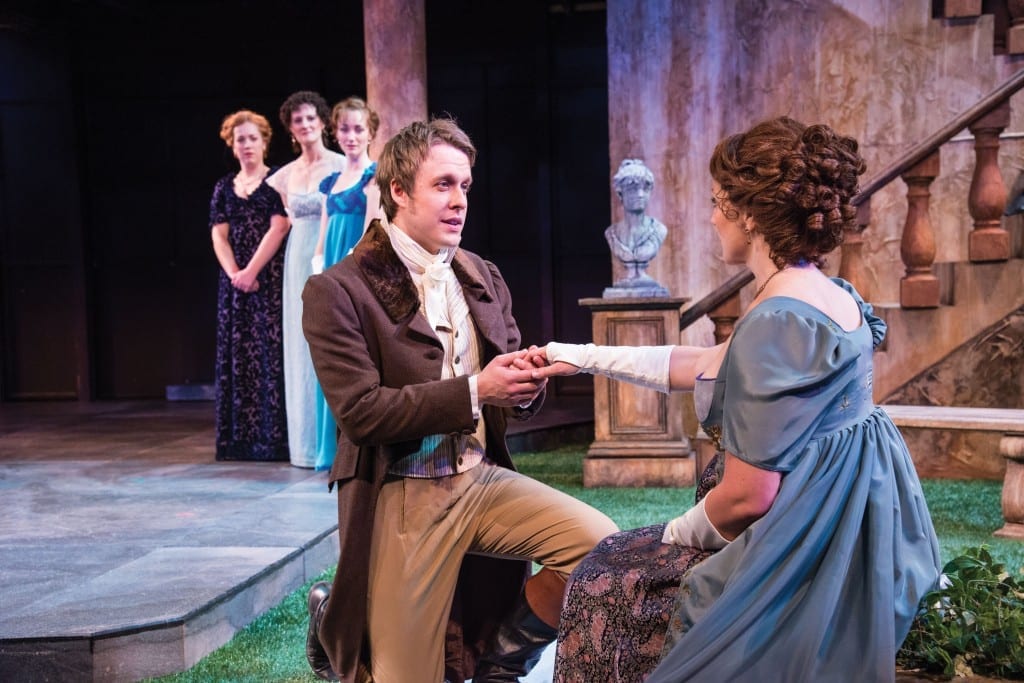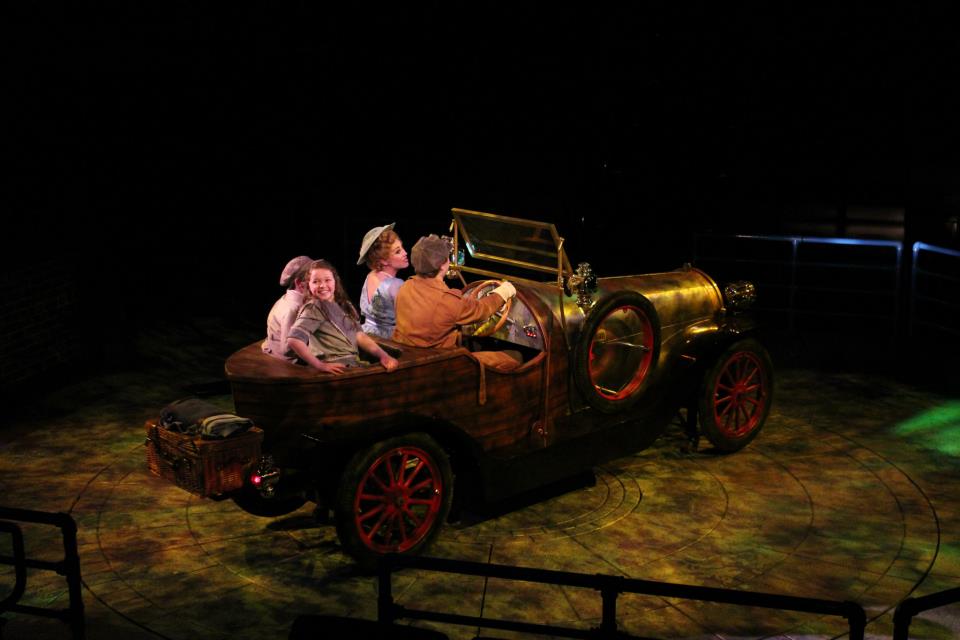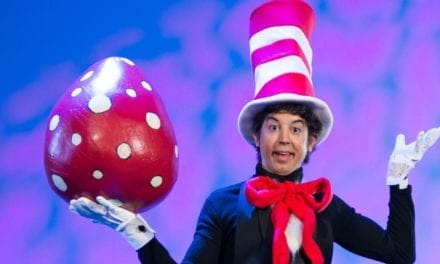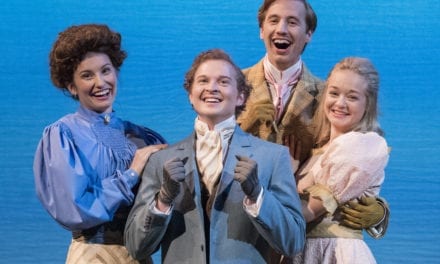CEDAR CITY — From the moment you walk into the outdoor Adams Shakespeare Theatre for the Utah Shakespeare Festivals production of Love’s Labour’s Lost, you are quickly pulled into a genteel world. The beautiful outdoor courtyard (designed by Robert Mark Morgan), with the strategically placed fountains and graceful statues, gives you an immediate sense of place for the story that is about to unfold.

Elizabeth Telford (left) as Maria, Melissa Graves as Princess of France, Siobhan Doherty as Katherine, Matt Mueller as Berowne, and Melinda Pfundstein as Rosaline. (Photo by Karl Hugh. Copyright Utah Shakespeare Festival 2013.) Show closes August 31, 2013.
That story is a classic Shakespearean battle of the wits between men and women. Ferdinand, the King of Navarre (Quinn Mattfeld) has entered into a vow with his attending lords Longaville (Robert Adelman Hancock), Dumaine (Jeb Burris), and Berowne (Matt Mueller) to abstain from rich foods, adequate amounts of sleep, and the company of women for 3 years. No sooner do they sign the paper than the Princess of France (Melissa Graves) and her attending ladies Maria (Elizabeth Telford), Katherine (Siobhan Doherty) and Rosaline (Melinda Pfundstein) arrive. Immediate attraction leads to big problems as the gentleman try to figure out how to woo these feisty ladies without breaking their vows—or, at least, without letting the other gentleman know.

Dan Frezza (left) as Sir Nathaniel, Henry Woronicz as Holofernes, and Thomas J. Novak as Dull. (Photo by Karl Hugh. Copyright Utah Shakespeare Festival 2013.)
Among the ensemble there are several standout performances. Pfundstein excels as the Lady Rosaline, leading the Princess and the rest of the entourage with her wit and sass. And while, for the most part, the women outshine the men, Pfundstein meets her match in Mueller’s Berowne. Mueller is charming and likeable and I can’t help but love him more and more as the night goes on. The verbal sparring between Pfundstein and Muller crackles with energy, adding sparks to the overall production.
Other performance highlights include Thomas J. Novak’s Dull, Jeanne Paulsen’s Boyet, and Matt Zambrano’s Don Adriano de Armado. From the moment Novak’s adorably dopey Dull tries to imitate the statue on the fountain, I know that he is the one to watch throughout the night. While often in the background, his verbal and facial reactions to the rest of the company often steal the scene. Paulsen is another welcome addition to the company, and her command of the language and comic timing adds life to every scene that she is in.

Betsy Mugavero (left) as Jaquenetta, Melisa Pereyra as Moth, Matt Zambrano as Don Adriano de Armado, and Chris Klopatek as Costard. (Photo by Karl Hugh. Copyright Utah Shakespeare Festival 2013.)
Zambrano, along with his trusty page Moth (Melisa Pereyra), is a little troubling at first. They push the stereotype of the Spaniard so far that it seems like they belong in a different play. However, Zambrano’s performance is so detailed, sculpted, and consistent, that he soon had me entranced. The details of the performance—from the sprinkling of Spanish words and phrases, the fiery arguments, and the addition of the Castilian “th”—left me wondering just what he is going to come up with next.
The choice by director Laura Gordon to update this Shakespeare story to a Regency time period is greatly supported by the design elements. The opening moment, with the classical music playing as the lords enter the stage in their fine suits, leaves little doubt of when or where we are. The music, designed by Barry G. Funderburg, continues to give the sense of time throughout the performance. However, it is the exquisite costumes, designed by Rachel Laritz, that deserve to be highlighted. The women’s dresses, in particular, are gorgeous to behold, and I sincerely appreciated Laritz adeptness at creating the subtle differences among the costumes that allow the audience to easily identify the various social levels within the court.
While entirely supported by the design elements, the actual choice to update the show to a Regency time period is somewhat befuddling. While the story doesn’t necessarily lose anything through the switch in time, there is nothing in that time period (other than the fact that I wondered when Mr. Darcy is going to make an appearance) that greatly adds to its significance or message. There were also several times throughout the evening when characters would throw in extremely contemporary verbal or physical responses that succeeded in pulling me out of the world that the design elements worked so hard to create.
This detraction is small in comparison with the biggest problem of the production: its pacing. The actors seemed determined to savor and draw out every moment possible, which undermined the comic potential of the entire production. When they did fall into the pace that the story demands—especially the scene before Intermission when the gentleman are caught writing letters to their loves, Berowne’s monologue, the “Russian” dance and the play within the play—the production sings. Unfortunately, it was not consistent throughout the night, which detracts from the show’s overall potential.
Overall, this production of Love’s Labour’s Lost is an evening of unrealized, or dare I say, lost potential. There are so many elements that have the potential of working together to make an amazing production, but, unfortunately, it doesn’t quite pull it off. The unrealized potential of the entire show is most keenly observed in the brilliance of the play within the play that occurs towards the end of the production. From the genius way that the set is transformed, to the commitment of the characters performing the play—including Dull with his sound effects, and the hilarious choices made by Moth, the Don, and Holofernes (played by Henry Woronicz) and Sir Nathaniel (played by Dan Frezza)—to the clever costuming choices, to the speedy bantering of the court, everything works together to create a delightful moment where the production truly brims with energy and humor. Unfortunately, it also leaves me wishing that the rest of the production had consistently reached that same level.





